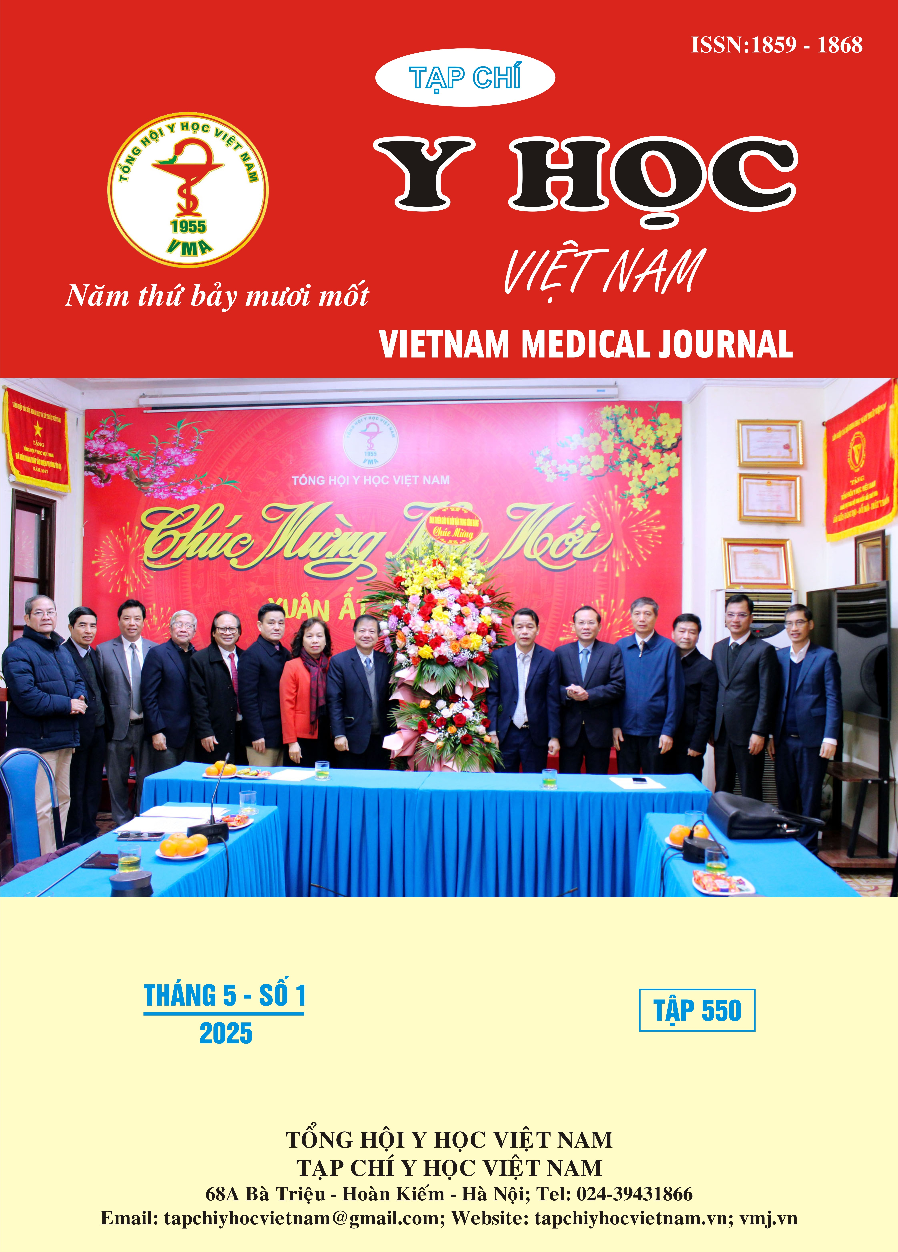COMPARISON OF CHANGES BEFORE AND AFTER SURGERY ON ULTRASOUND AND RENAL SCINTIGRAPHY IN CHILDREN TREATED FOR CONGENITAL HYDRONEPHROSIS DUE TO URETEROPELVIC JUNCTION OBSTRUCTION BY LAPAROSCOPIC ASSISTED RETROPERITONEAL ONE-TROCAR
Main Article Content
Abstract
Objective: To evaluate changes before and after surgery on ultrasound and renal scintigraphy in children treated for congenital hydronephrosis due to ureteropelvic junction obstruction by laparoscopic-assisted retroperitoneal one-trocar surgery. Subjects and Methods: We conducted a retrospective study of 70 patients under 5 years old diagnosed with congenital hydronephrosis due to ureteropelvic junction obstruction and who underwent surgery with laparoscopic-assisted retroperitoneal one-trocar surgery between January 2011 and June 2013. All patients were diagnosed with congenital hydronephrosis due to ureteropelvic junction obstruction using imaging methods such as ultrasound, intravenous urography, MRI of the urinary system, and scintigraphy. Postoperative results were evaluated 6 months after surgery based on ultrasound measurements of the anteroposterior diameter of the renal pelvis, renal parenchymal thickness, renal function, and the urinary excretion curve on renal scintigraphy. Parameters such as age, gender, renal pelvis size on ultrasound, and urinary excretion patterns on renal scintigraphy before and after surgery were recorded. Results: A total of 70 records met the criteria for the study period; 65 male patients (92.86%) and 5 female patients (7.14%); age ranged from 1 month to 5 years (mean age 22.9 ± 18.6 months). 100% of patients had preoperative ultrasound. The average renal pelvis size before surgery was 34.3 ± 8.1 mm (ranging from 25 mm to 50 mm). The renal parenchyma thickness was 4.2 ± 1.0 mm; the thinnest was 2.5 mm, and the thickest was 7 mm. 56/70 (80%) patients underwent renal scintigraphy before surgery. The average renal function before surgery was 47.9 ± 9.8%. 36/56 (64.3%) patients had an accumulation-type excretion curve, and 20/56 (35.7%) patients had a slow urinary excretion curve. No patients had a normal urinary excretion curve. 51/68 (75%) patients were followed up for 6 months and all underwent ultrasound. The average renal pelvis size after surgery was 14.3 ± 5.1 mm (ranging from 5 mm to 31 mm). The average renal parenchyma thickness after surgery was 7.6 ± 1.8 mm, with the thinnest being 5 mm and the thickest being 13 mm. 33 patients underwent renal scintigraphy. The average renal function postoperatively on renal scintigraphy was 50.6 ± 6%, with 19/33 (57.6%) patients showing a normal urinary excretion curve. Conclusion: Ultrasound and renal scintigraphy are essential examinations for monitoring and assessing postoperative outcomes in children with ureteropelvic junction obstruction.
Article Details
Keywords
Hydronephrosis, ureteropelvic junction obstruction, laparoscopic reconstructive surgery
References
2. Bansal R, Ansari MS, Srivastava A, Kapoor R. Long-term results of pyeloplasty in poorly functioning kidneys in the pediatric age group. J Pediatr Urol. 2012;8(1):25-8.
3. Chertin B, Pollack A, Koulikov D, Rabinowitz R, Shen O, Hain D, et al. Does renal function remain stable after puberty in children with prenatal hydronephrosis and improved renal function after pyeloplasty? J Urol. 2009;182(4 Suppl):1845-8.
4. Tabel Y, Haskologlu ZS, Karakas HM, Yakinci C. Ultrasonographic screening of newborns for congenital anomalies of the kidney and the urinary tracts. Urol J. 2010;7(3):161-7.
5. Shokeir AA, El-Sherbiny MT, Gad HM, Dawaba M, Hafez AT, Taha MA, et al. Postnatal unilateral pelviureteral junction obstruction: impact of pyeloplasty and conservative management on renal function. Urology. 2005;65(5):980-5; discussion 5.
6. Matsumoto F, Shimada K, Kawagoe M, Matsui F, Nagahara A. Delayed decrease in differential renal function after successful pyeloplasty in children with unilateral antenatally detected hydronephrosis. Int J Urol. 2007;14(6):488-90.
7. Yang Y, Hou Y, Niu ZB, Wang CL. Long-term follow-up and management of prenatally detected, isolated hydronephrosis. J Pediatr Surg. 2010;45(8):1701-6.
8. Ylinen E, Ala-Houhala M, Wikstrom S. Outcome of patients with antenatally detected pelviureteric junction obstruction. Pediatr Nephrol. 2004;19(8):880-7.
9. Kaneyama K, Yamataka A, Someya T, Itoh S, Lane GJ, Miyano T. Magnetic resonance urographic parameters for predicting the need for pyeloplasty in infants with prenatally diagnosed severe hydronephrosis. J Urol. 2006;176(4 Pt 2):1781-4; discussion 4-5.
10. Abdelazim IA, Abdelrazak KM, Ramy AR, Mounib AM. Complementary roles of prenatal sonography and magnetic resonance imaging in diagnosis of fetal renal anomalies. Aust N Z J Obstet Gynaecol. 2010;50(3):237-41.


